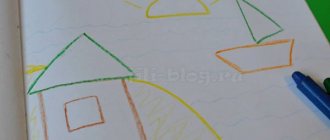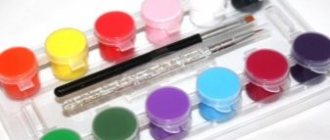Drawing for a child is not only a useful and exciting skill, it is a way to express their personal “I”.
Although some parents do not see the point in children's scribbles, the first drawings indicate the functioning of the brain and teach the baby to think and analyze. The benefits of drawing for children are a scientifically proven fact, repeatedly confirmed by parental experience.
Teaching drawing to a child 2-3 years old
You need to get the most out of the image. The child first draws with vertical, wavy lines. He still has difficulty coloring objects.
First line technique
First you need to introduce your child to drawing subjects. The hand should hold the pencil correctly, the brush should be rinsed in a glass of water. The best way to learn is through demonstration. You can sit down at the table next to your baby, take a pencil and start drawing your drawing, or try to control your child’s hand. You need to take more paper to spread it all over the table.
Important! It should be understood that drawing with children 2-3 years old starts small. To begin with, you need to be content with incomprehensible lines.
The benefits of drawing for child development
Drawing helps you understand the world faster, but this is not the only advantage of such activities, there are others:
- development of fine motor skills of the hands. At 2 years old, the baby learns to hold objects and direct them correctly. Children become smarter and their speech develops faster. Psychologists describe the presence of reflex points on the fingers, from which the signal enters the brain. From their stimulation mental abilities develop;
- the emergence of purposefulness;
- figurative thinking. In the future, for memorization, it is important to associate objects with images;
- emphasizing attention and imagination;
- development of mathematical abilities and logic. Shapes of objects, comparison, equality - these are simple concepts in mathematics that are ingrained in childhood.
The role of drawing in the development of a child
Drawing is directly related to imagination, speech, mental activity and perception of the surrounding reality. Fine art enhances and organizes these mental functions, helping the little artist to systematize his idea of the surrounding reality.
The more actively a child understands the world through games, the better he draws, developing his creative abilities, and therefore developing his intellect. Giving your baby a pencil and paper is not only a way to keep him busy for a while.
The benefits of drawing for children are undeniable and scientifically proven, since artistic activities:
- give joy. Drawing becomes a hobby for the child, which brings great pleasure, as it gives freedom of expression;
- develop perseverance and accuracy. Holding a pencil in hand is not an easy task for a child, and depicting a specific object is a painstaking and difficult task. While performing it, the baby goes through an important process - the development of fine motor skills: the better he masters this stage, the faster speech will develop;
- train memory, attention, improve spatial imagination;
- help to cope with emotions, making the baby happier and freer, because through drawing the baby “splashes out” on paper his feelings, which due to age he cannot express through speech;
- develop creative potential. Creating a drawing or painting requires a child to have an individual vision of objects, requires a creative approach to the creative process, the ability to admit one’s mistakes and, as a result, create something unique;
- calm the psyche: it is especially useful to draw for children prone to whims and neuroses;
- help reveal individuality. When drawing, a child feels like a creator, an individual, which makes him more confident and has a beneficial effect on self-esteem.
From a child's drawing you can understand who its author is - a boy or a girl. This is a scientific fact. Girls have better developed verbal and logical thinking, emotions, and attention to detail. They are focused on a specific image, they like to draw princesses and animals. Boys are distinguished by spatial imagination, so they usually depict dynamic pictures - battles with equipment and weapons.
Only a child psychologist can interpret the drawing and only taking into account the child’s own comments. If a child prefers to depict objects in black, this does not mean that he is depressed, but simply an association with his father’s car.
How to interest a child
In any business, the most important thing is interest. You can get used to drawing if your child loves it. There are several ways:
- Emotional perception of an adult. The parent should praise and rejoice. Through the emotions of an adult, you can achieve success in drawing a child.
- Turn the lesson into a game. You can come up with a game plot that will be interesting to the baby. For example, a bunny asks for a carrot, you need to draw it. The game should be filled with meaning. You can conduct a dialogue, show the child a toy hare.
- Process. We must not forget about the most important thing. The first drawing will definitely impress the little one, so there should be a lot of different paints, pencils, and felt-tip pens on the table. Many new objects are the main attribute of the first “picture”. The second and third pictures will be even better.
GCD for familiarization with the outside world in the preparatory group
Teach or let the child act independently?
There is no consensus. Some parents and teachers believe that if a child has a talent for drawing, it should be developed by enrolling the child in an art studio. However, traditional training can slow down the formation of an individual style.
Opponents of art schools are convinced that creativity is not following canons and guidelines, but a process of self-expression. A child must draw as he sees, and any templates will negate creative expression.
If you decide to study in a circle, you should first meet the studio teacher and find out reviews about his work.
It is important to remember that drawing is taught not by a technique, but by a person. It is the teacher-artist who is able to reveal talent and help the child show his individuality.
Psychologists note that the cause of shyness in adults is often a situation from childhood: parents, wanting to see more realism in their child’s drawings, criticize the child. The result is uncertainty and fear of expressing yourself.
Image techniques
To understand how to teach a child to draw at 3 years old, you need to consider drawing techniques. From a variety of options, you can choose the most effective ones for your baby.
Poking technique
- Poking drawing. The adult selects the plot of the template that needs to be supplemented. It is recommended to choose a semi-dry, hard bristle brush with gouache paint. A felt-tip pen will also work. You can color a snowman, animals, plants. This technique will help you learn how to color.
- Dipping. For this method it is better to choose paints. The child holds the brush diagonally closer to the table (in the vertical poke technique) and leaves brush marks. These could be tracks of an animal, lights on a Christmas tree, patterns on clothes. You can print a black and white picture or draw it yourself.
- Fingerprints. Apply a little paint to a white sheet and show how to paint with your fingers. You should be careful when choosing paints, because babies’ skin is very delicate and susceptible to allergies and irritations. You should choose gouache and watercolor.
- Drawing with lines. This is a more complex stage that needs to be introduced after studying the first three techniques described above.
Workspace organization
The workplace should both attract and teach organization.
- First you need to take care of the child's health. The table and chair included must be adjusted to the height of the child. The back is rigid for correct posture. During work, you need to monitor his body position, carefully guide him without knocking him out of his work.
- Interesting design. It’s always nice when your child’s desk matches the interior of the room, but you shouldn’t forget about visual perception. The workplace should attract the little one.
- Before drawing with children 2-3 years old, you need to prepare a table. It is advisable to do this in front of a child. Carefully laid out paints and pencils will teach him order. After classes you need to clean everything up. Again, you can come up with a game that will teach your child to keep order, then in the future during school lessons he will keep his workplace clean.
At what age should I start?
There is no need to rush the event. Experts recommend introducing a baby to drawing from the age of eight months: by this time the child can sit confidently. It is advisable to start with finger paints and a large sheet of paper. You need to be prepared for the baby to get everything dirty.
Some psychologists believe that teaching children to depict real objects: clouds, trees, houses, geometric shapes is not recommended until the age of 8, so as not to discourage the little artist from wanting to draw.
It should be understood that preschool children convey their visual and tactile sensations from the object in the drawing. They are not interested in the similarity of the object. The period of doodle drawing has its own stages and at this time it is important to prevent the baby from blocking this process:
- chaotic scribbles (up to a year) . This is the time when a child just picks up a pencil, pokes it at a piece of paper, rejoicing that traces remain there. Parents should provide feedback to the baby, reacting positively to his creativity;
- circular scribbles (1-2 years) . Now the baby realizes that he can control his movement and actively draws circles, lines, and squiggles. At this stage, parents are tempted to teach their child to draw correctly: a square house, a round sun. Such actions block the child’s imaginative thinking;
- advanced doodles (2-3 years) . This is the last period of “pre-fine” drawing, in which the baby discovers that there is meaning in the circles, dots and curved lines he draws. The process should bring joy to the child: in order to maintain the child’s self-esteem, parents should even hang doodles on the wall, admire them and proudly show them to friends.
Realistic appearance of objects appears in children's drawings only by the age of 7-8 years. It is during this period that the child has a desire to evaluate an adult in order to achieve a better result and the question arises about the need to continue studying at an art school.
How to teach a 3 year old child to draw
The first image should interest the child so that next time he starts drawing again. To teach a 3-year-old child to draw, you can use one of the techniques.
Hatching on coloring books
- The coloring technique will help your child choose the right colors. You need to help him not go beyond the line by coloring two or three objects yourself. You need to start with simple coloring books: a house, a car made of shapes, a flower.
- Technique of improvised means. You can try drawing with toy vehicles or threads. You can lay out patterns with them and then paint them.
- Drawings that develop mathematical skills: lines, ovals, circles. These can be provided as templates. For example, a drawing of a boy with colorful balls.
Modern technologies for speech development of preschool children according to the Federal State Educational Standard
Interesting drawing ideas
Interesting image options can give the child more knowledge. Choosing the right coloring book is the responsibility of the parent.
You can make your own coloring in the form of the seasons, combining all the image techniques.
- autumn: dipping technique for colorful leaves;
- winter: poke technique for the New Year tree. A winter landscape provides many ideas (a snowman for understanding shapes, sports equipment for introducing activities);
- spring: dipping technique for drawing buds and first leaves;
- summer: understanding shapes (ice cream), drawing with a poke (flowers).
What topic to choose
Parents often have questions about how best to draw: painting objects step by step or first seeing the finished result. It is difficult for a child to select exact colors for objects, so it is better to initially demonstrate how, for example, a flower should look, and then complete the drawing step by step.
Note! The topic must relate to real objects. No need to start with coloring pages of non-existent cartoon characters. You can even show off the item for the image first.
Drawing with fingers and palms
Children may be interested in hand painting. Using this technique you can depict flowers and the sun. The method is very easy, since no additional items are needed for the lesson.
For your information! There are special finger coloring books on sale.
Picture of palms
Should I send my child to a drawing class?
The optimal age for a child to study in a circle is 4-6 years. Your baby's social communication skills should develop gradually.
Important! A sudden introduction to a group of guys can be stressful for him. There is no need to rush into learning; the basic basics can be learned at home.
Recommendations from psychologists and teachers
Psychologists note the importance of feedback between adults and children. Drawing not only gives certain skills, but also brings parents and baby closer together. Teachers advise starting with coloring books so that the child remembers the object itself. It is still difficult for him to depict a flower that he saw on the street once. Simple lines can also be the goal of drawing for children 2-3 years old.
The first “picture” for the baby is a step towards a complex activity. It is useful to develop drawing skills to improve mental abilities. When choosing basic techniques, you need to choose the most suitable and interesting one for the child. Don’t forget about personal contact with the baby, then drawing will not just be a lesson, but will develop into a hobby.
Neskuchnoye Fine Arts: the best family painting studios in Moscow
Is there an artist growing up in the family who tirelessly draws on wallpaper? Direct his energy in the right direction - take him to the painting studio. Better yet, join in and create together! Yozhikezhik has compiled a list of the best places for children under 12 years old and their parents. All you have to do is choose.
ART THERAPY STUDIO “SAMO”
Cost : subscription for 10 classes lasting 2 hours - 11,500-14,000 rubles. depending on the time, day of the week and age of the child. Addresses : st. Krymsky Val, 9, building 4 (CCA "GARAGE"), metro Gorky Park, there are also classes at MMOMA (Moscow Museum of Modern Art), st. Petrovka, 25, Chekhovskaya metro station. Tel. +
The specialization of this studio at the GARAGE Center for Contemporary Art is art therapy, that is, the opportunity to understand oneself, solve some problems, overcome fears and The specialization of this studio at the GARAGE Center for Contemporary Art is art therapy, that is, the opportunity to understand in yourself, solve some problems, overcome fears and complexes, reveal your potential through creativity. Both children and adults can take classes; there are both individual and group classes. For children, groups are divided by age: 3-5, 6-8 years, no more than six people in a group.
When working with young guests, the emphasis is on creating a positive social experience. When you come to SAMO, you need to remember: classes here are not just a form of leisure; at meetings, children will definitely devote time to various artistic techniques, from drawing to clay modeling, to outdoor games and reading.
STUDIO “FLYING AND SHAGAL”
Cost: 1250 rubles – for a two-hour lesson. Addresses: Krasnoarmeyskaya, 4, Dynamo metro station; st. Bolshaya Nikitskaya, 47, building 3, Jewish Cultural Center, metro Arbatskaya; Leninsky Prospekt, 39/1, in the building of the EYO yoga studio, metro Leninsky Prospekt; Bobrov lane, 6, library-reading room named after. I.S. Turgenev, metro station Chistye Prudy. Tel.
The art studio with the original name was created for everyone who truly loves art. Its highlight is the “Chronological Tape”: each lesson is dedicated to a certain era, getting to know the artists of that time, on the basis of this information, presented in the form of slides, the lesson is built. Children over two years old and their parents can sculpt, draw, make crafts, participate in exhibitions and events organized by the studio, and go to museums on thematic excursions. There is no preaching, everything is family friendly and very interesting.
PEROTTI SCHOOL OF PAINTING
Cost: 1 lesson (2 hours) – 1600 rubles, subscription for 12 classes – 16000 rubles, subscription for 32 classes – 40000 rubles. Address: Moscow, st. Marina Raskova, 16/18, Dynamo metro station. Tel. +7 (495) 612-0792; +7.
Artists Svetlana and Federico Perotti are a married couple, owners and founders of the school, practicing the method of “intuitive painting”. They believe that everyone has inherent creative abilities; they just need to awaken them. Usually, by the end of the first lesson, even the most inexperienced student takes home a real painting. The school regularly hosts exhibitions of both teachers who work here and students. Here you can practice art therapy, devote time to painting furniture, ceramics or intuitive painting, frescoes, drawing portraits and much more. The school offers group education for children over 4 years old and adults.
STUDIO “I WANT TO DRAW!”
Cost: one-time lesson for children – 1000 rubles, for adults – 1200 rubles. subscription for 10 classes – 7,000 rubles. Addresses: Vernadsky Ave., 92, residential complex "Crown", metro station Yugo-Zapadnaya; Marksistsky lane, 3, metro station Marxistskaya. Tel. , +7 (926) 395-17-07
A good opportunity for mothers who want to study with their child and take a more in-depth or specialized course is fashion illustration. All the methods here are original, developed specifically for studio students, the teachers are passionate, the atmosphere is friendly and creative, and the approach to everyone is individual. There are many groups for children: this includes the development of imagination, and painting not only with paints, but also with plasticine, graphics, appliqués, and painting on wood. The studio conducts on-site master classes in city restaurants, festivals and other events.
ART STUDIO IN "MUSEION"
Cost: course of classes – 7000 rubles, for preferential categories 50% discount. Address: Kolymazhny lane, 6, building 2, Kropotkinskaya metro station. Tel.
In the "Museion", the center of aesthetic education at the Pushkin Museum. A. S. Pushkin, there is also an art studio for children 5-6 years old. Older visitors (8-10 years old) can enroll in a ceramics workshop. What is noteworthy is that the art studio in the museum is a priority; the Pushkin Museum recruited its first students in the post-war years. At Museion, they offer to awaken your imagination and teach drawing skills through classes not only in the studio at an easel, but also while walking through the museum halls. Students bring to class work they have done at home, and together they work on mistakes. It's a pity that classes are held only twice a month. To enroll, you must pass an interview and bring your work with you. Read more in our review “Museion for children and their parents.”
SCHOOL OF PAINTING "ARTVILLE"
Cost: one-time lesson for children 1300 rubles, subscription for 4 lessons 4500 rubles; for adults 1 lesson (4 hours) – 3000-4000 rubles; subscription for 4 lessons - 10,000 - 12,000 rubles. Address : Rublevskoe highway, 91 k1, Molodezhnaya metro station. Tel. +7 (925) 755-61-64
The ArtVille school belongs to the category of classical painting schools; programs for children are compiled individually, taking into account capabilities, age and existing skills. Of course, it is better to start getting acquainted with painting from a young age. At the same time, studio experts say that it’s never too late to learn to draw. Holding a brush in his hand, the child develops his thinking, visual memory, and learns to see beauty in small things. The space for creativity (watercolor, gouache, pastel) is open to children over four years of age. There are also many programs for adults, from the basics of classical painting to an icon painting course. For its students, the school organizes outdoor plein airs in the Moscow region all year round, and in the summer - to France or to a base on the picturesque shores of Lake Issyk-Kul.
WORKSHOP “LITTLE CHILDREN AND GREAT ART”
Cost: lesson - 1000 rubles, discounts available. Address: Bolshoi Afanasyevsky lane, 27, building 2, 2nd floor, metro station “Arbatskaya”/“Smolenskaya”./ “Kropotkinskaya”. Tel. +7 (916) 641-18-60
The location of the workshop is captivating - children are introduced to beauty in the center of the capital, in an old mansion built at the end of the 19th century for the sculptor Nikolai Andreev. Since then, the amazing building has not changed its purpose, remaining an art workshop - there is literally a creative atmosphere in the air here. Students are divided into age groups - 2-3 years, 4-6 years, schoolchildren and adults. Each lesson begins with a mini-lecture on the topic of art in an accessible playful form, for example, in the form of a fairy tale with pictures. Then the children draw, sculpt, make collages and assemblages, mosaics, and do ceramics. And it all ends with tea drinking and discussion of the topic. Pre-registration is required.
STUDIO MAGICHANDS
Cost : 5 hour lessons – 2500 rubles. Address : Chayanova str., 16, Novoslobodskaya metro station. Tel. , (495) 971-20-88
Studio Magichands is children's drawing in a cozy environment, with professional teachers and a warm attitude towards each student. The teachers promise that the child will learn to draw in just 2 lessons and will enjoy not only his own paintings, but also the process of creation itself.
During the lessons, kids will be shown how to correctly convey perspective and make details proportional, how to feel colors and work with a palette. Classes are held in small groups; everyone aged 3 years and older is invited to attend the course. And if you don’t want to leave your child alone, you can draw together - there are special conditions in the studio for children with parents.






